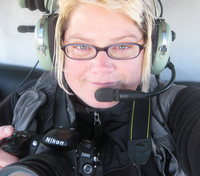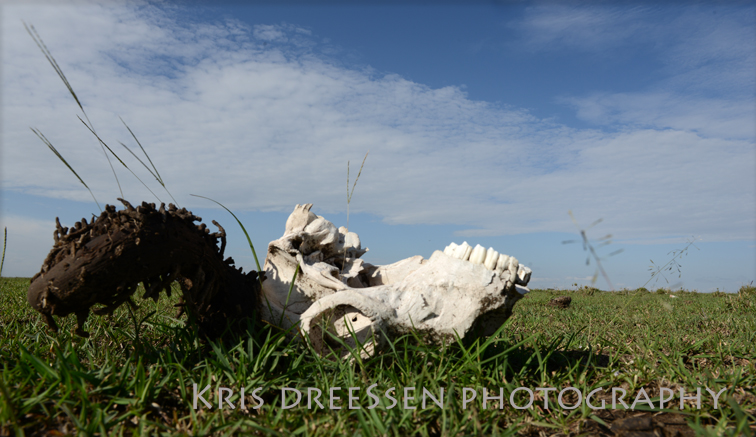
*8.17.14
Bushwalk 6:21 PM
"Skulls. Skeletons. I like to photograph them in the landscape and make them look interesting and sort of beautiful, because they are usually shied away from and people just think they’re gross."
— Me.
A bush walk in the Masai Mara area is more of a big open expanse of African plain walk. You can see for miles and miles, the land a rich deep dirt and scrubby green grass, punctuated with a single flat-top tree once in a while and then patches of deep brush with some acacia trees.
You walk in the open, nearly like a Midwest plain. It reminded me of the openness, skies and breezes of Montana and Wyoming, away from the mountains.
I met James, a guide here at Porini Lion, and two rangers — a very big tall man named Ken and the much smaller and quieter George. They are not Masai. They wear camouflage and carry big rifles, and an umbrella I’m guessing if they and I need it when it showers. There is a reason this is called Lion Camp. I've seen tons and this one was about .5 miles from the camp yesterday mornig:
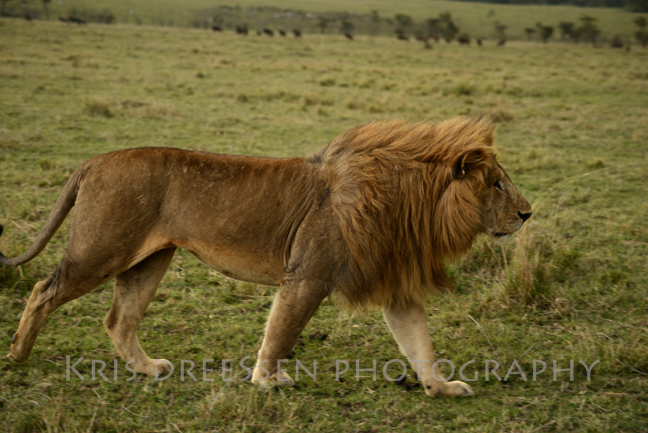
It was sort of strange to see James hand these two gun-wielding toughies umbrellas.
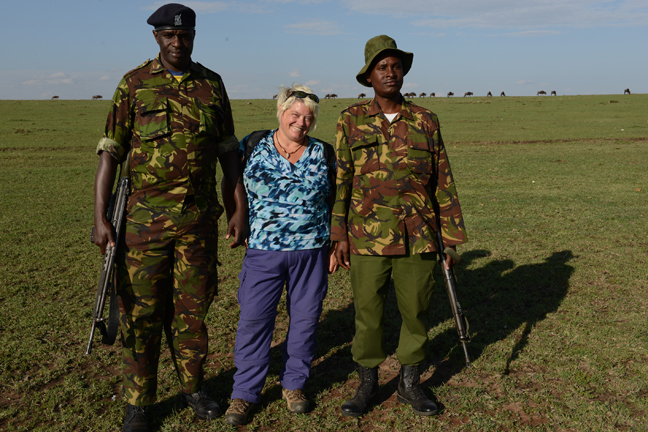
I let them know, hey, just so you know, I’m deathly allergic to wasps and bees, so if you see a lot of them, or a swarm of them, let’ s not go there. I always let them know.
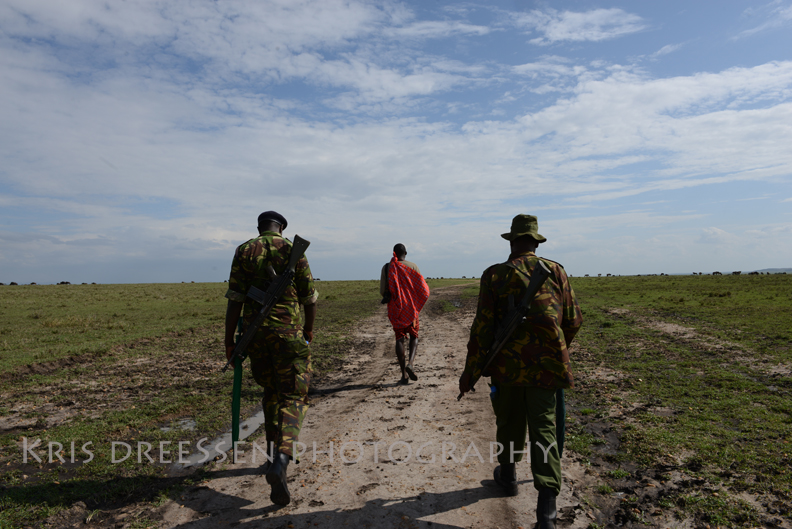
We set out across the plain, and first through what seems to be the resident herd of zebra. They have larger herds, and don’t tend to travel too very far, so it could be the same ones every day or so that I see outside the tent, and about 500meters to 1000 meters away.
There is a herd of wildebeest — what I now learn is also referred to as a “gnu” — but even walking, as we near they all take off like the fraidy-cats they are and should be in this wild place, where they are the easiest and most often-killed prey for lions.
It’s appropriately called Lion Camp here; today in the morning we saw three lionesses and 10 cubs. Yesterday, so many I really don’t know how many we saw, so there are lots of lions to eat them.
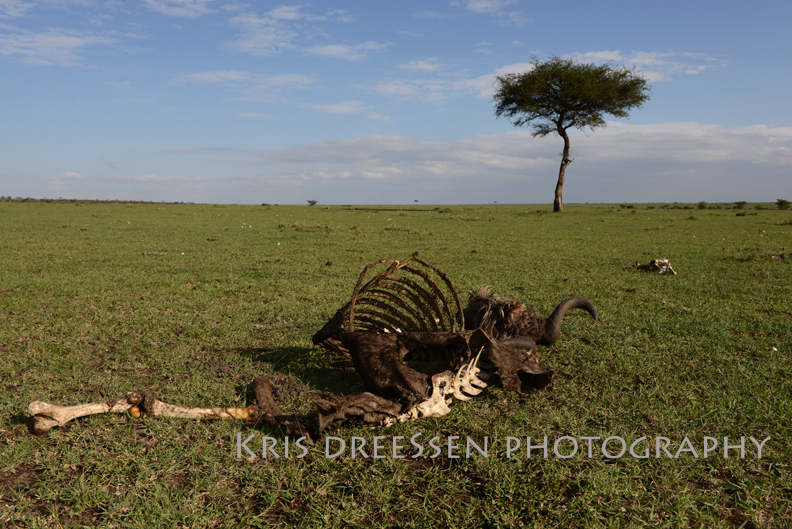
The place is just littered with little bones and skulls … plenty of wildebeest get eaten each night, especially during this migration time, when there are hundreds of thousands of them crossing the Mara River.
They are interesting as artifacts go, and I like to photograph them in the landscape and make them look interesting and sort of beautiful, because they are usually shied away from and people just think they’re gross.
I take lots of them, these wildebeest skulls you cross every few minutes of walking. I even find an entire wildebeest, against another skull, against one of the solitary trees that dot the landscape.
James doesn’t seem as curious as to why I’m taking the photos; on the bush walks, more people do it.
There’s a big herd of wildebeest in the horizon, so I take a photo of James and the two rangers against the big open sky … it’s so easy to show the vastness of the place, and how small we are in it.
How many animals and really how small they still look, the massive beasts they are. It is difficult to imagine how large these conservancies and national parks are, and still even more to imagine what it was like before they were confined to these small areas and protected.
We rest under the shade of this solitary tree, and stare out at the two buffalo about a high-school track — unhooked as an oval and spread out — away. One is looking and moving his head side to side, getting the scent of humans.
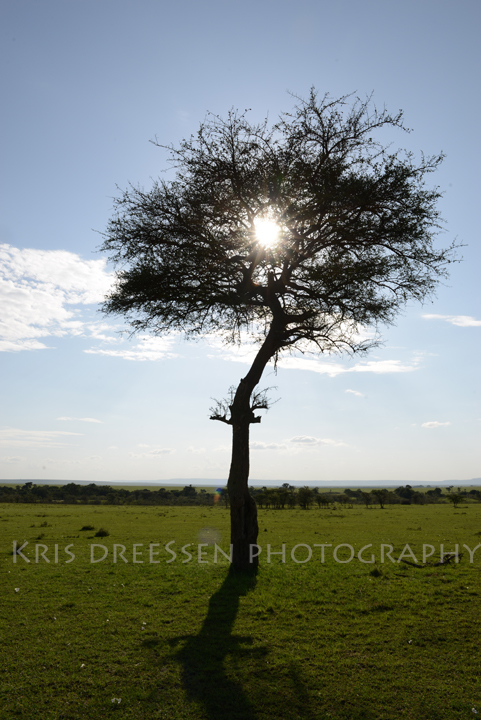
They are the ones to look out for, say the Masai. Hippos and buffalo are the ones that injure people; James says really it’s the buffalo. You only worry of hippos if you get between them and the river. The buffalo? They will charge you more easily and if you play dead? They will lick you with their rough tongues to rouse you from your silly tactic, then gore and stomp you.
As it is though, really, you can just walk across the open plain and if you don’t get into their space, or go into the bushes where you can’t see what’s hiding in there — say a leopard sleeping and you scare it — you go on your way, as we do We just sit under the tree, watching the buffalo.
People are out here walking around all the time, the Masai are herding cattle and goats near the villages, and it’s not that these things are just outright attacking people all the time.
As it is, i’m fine UNTIL A SWARM OF AFRICAN BEES COMES.
I’m talking to James about how wow, I didn’t know lions and a lot of other animals out here are color blind … and interesting factoid: the reason lions dont care if you are in the Land Rover, right next to them, is they smell and hear you, but see the truck as a sort of box thing. If you step out, you look like a smallish thing that they can easily kill….
“Kris!” And something like duck or the equivalent of Watch out!
I see James at the same time take his Masai bright-red plaid shawl and toss it over his face and duck. I pull my shirt up over my ears and bow my head as fast as I can, as he did, with a lot of flies seeming to buzz around me. As I go down I see hundreds of them, and realize as I bury my head into my bosom that ugh, they likely bees.
It is silent and I’ve got my hands clapped over my ears and I’m not too comfortable … **** holy crap, it’s a swarm of African bees ON ME!!!****
It’s over as soon as it starts it seems, as James says “they’re gone.”
It was a swarm moving on its way, and we were in their path. I’m not sure there’s an outstandingly sound reason for it, but the Kenyans cover their faces first and stay still. which sounds like a solid plan as your face is “out there.”
Ken tells me that you usually have toothpaste and perfumes and soaps etc on your face, and they can maybe be more easily attracted to it.
And, they came since you talked about them, He says, laughing.
We joke about how I’m out here and the lions and those mean buffalo are fine, you can walk across for 2 hours, but I’ll be killed by the bees.
James used to like bees, but when he was little he was attacked and stung by many. “I nearly died, so I changed my mind about them.” I know the feeling.
“I like bees, but I can die if I’m stung so I have to be afraid of them. I wish I did not,” I say.
Before us is a herd of wildebeest with a single Thomson gazelle in the middle, trotting around like a tiny deer, it’s white legs jutting out and its black tail going in swinging side to side like a pendulum of a Grandfather’s clock on warp speed. Hilarious.
Wildbeests will sometimes stray from the herd, and then they hook up with zerbras. Same with zebras who stray. They will join a herd of wildebeest as there’s strength in numbers.
We walk some more and I tell James, Ken and George why the walk was important.
First, I feel like veal in the Land Rover. Ride around and get hungry, then eat. Never walking around.
Once out here, it gives you an entirely different perspective of the landscape. It is a tremendous African plain, stretching for miles and miles, but you don’t feel it until you are standing in it, feet on the dirt, looking and feeling small against the expanse of sky and field going on and on and on, and the zebras and herds of hundreds of wildebeest before you — all dwarfed by the landscape.
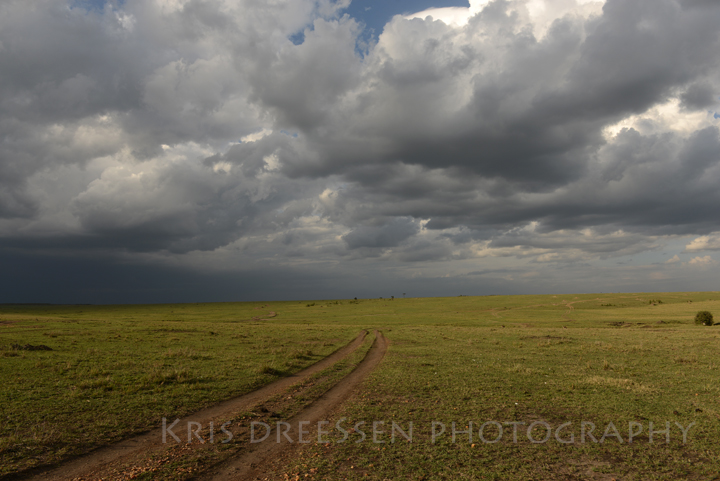
I tell James the only thing I would change about this camp is the ability to interact with the staff - who are all Masai. In adventure camp in Selenkay, by nature of its being tents and so we’re all outside of them, we spent most the time with the guys - and they sat with us at the fire.
I find out anyway that James has been a guide for three years, fresh out of guiding school. He loves animals and learning about them, which is why he wants to be a guide. His village is one hour and a half walking from the camp and he goes home about a week every month. In high season, like now, maybe every 2 months. James loves the leopard. He’s the smallest predator but he’s beautiful and interesting.
Ken and George aren’t Masai; they go home for 5 days out of a month. Geroge has no favorite animal and Ken, it turns out, despite being a ranger and protecting them, doesn’t “really like wild animals. I am afraid they are going to eat me,” he says, laughing, which is another reminder that people are not what they look like — the tallest, biggest African guy I’ve met so far, laughing that he’s afraid of the animals, holding a rifle.
A few weeks ago, he was out by himself, sans gun, and a lioness who was protecting her cub roared and started to chase him.
“She made the biggest noise, and I did too,” he says, laughing how he took off running and the other staff came to see if he was dead or not.
